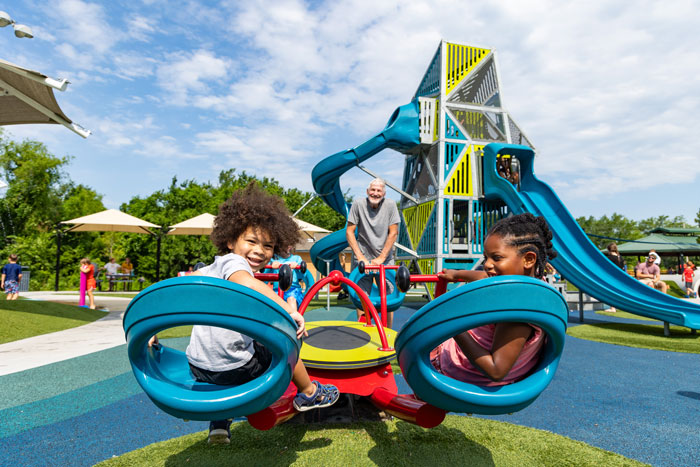There has certainly been much written about the benefits of play for children, but in recent years there’s been an increasing focus on the benefits of younger and older generations playing together. And since environments such as playgrounds and parks are ideal spaces to foster this intergenerational engagement, designers and operators of these spaces are striving to include features that appeal to a wide range of visitors and create opportunities for connection across generations, as research shows that settings designed for intergenerational use have high rates of return visits.
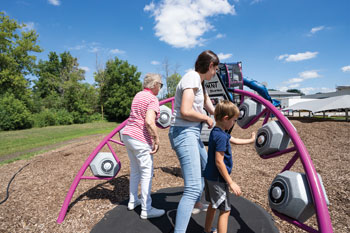
Jen DeMelo is vice president, strategic partnerships & organizational innovation at KABOOM!, a nonprofit with a mission to “end play space inequity for good.” She believes it’s critical to promote the socialization of all different ages of people.
“When we start to think about play spaces as oases of joy, why wouldn’t we want different age ranges coalescing together to experience that? There’s also some developmental benefits for children when we start to see caregiver and child interactions as it relates to literacy outcomes and some of the other social outcomes associated with what we think these types of environments can support.”
Anne-Marie Spencer, corporate vice president of marketing for a company that both develops research and offers a broad range of products, programs and services focused on recreation, play and outdoor spaces, points out that the term “multigenerational” really just means people from various generations are present. “I prefer to say ‘intergenerational,’ referring to an active exchange, or ‘inter’ action between people of different ages. That’s where the magic happens!”
Spencer went on to discuss the aging of the world’s population. “The global population aged 60 years or older numbered 962 million in 2017, more than twice as large as in 1980 when there were 382 million older persons worldwide. (Those numbers) are expected to double again by 2050, when it’s projected to reach nearly 2.1 billion.” So it only makes sense to offer recreation opportunities for this aging population, alongside their younger counterparts.
Jill Moore, an inclusive play specialist at a Delano, Minn.-based company that designs playgrounds and manufactures products for outdoor spaces, pointed to a study conducted by Studio Ludo/Kaiser Permanente where one key finding showed that there were more caretakers at the park than children at most given times. “So, when it comes to the design of play, a real focus has been made on ensuring the designed environment is comfortable for the adults using the space. Not only from the play perspective, but also integrating activities throughout the park space for adults to engage in.”
One of those activities involves the use of outdoor fitness equipment, which Moore said has been a huge hit, especially since there are options that vary in challenge. She mentioned how their outdoor fitness system with a focus on more mainstream exercises has been “placed along fitness trails or next to the playground so that caretakers can work out while children play.”
And she said that people enjoy the “ninja warrior” feel of more extreme fitness offerings, especially as parkour has grown in popularity. “We’ve seen that integrated as a feature for adults in parks, but we’ve also seen it integrated into a few schools as their recess equipment or used for PE classes. Outdoor fitness equipment really invites people of all skill levels to explore fitness.”
Spencer agreed that some of the most successful products for encouraging family interaction—and one of her favorites for incorporating into intergenerational setting designs—are challenge courses. “Not the kind where you have to be a ninja athlete to complete the obstacles, but the fun kind that are more playful and offer a multitude of ways to traverse obstacles, so they are achievable by people of many abilities and ages.
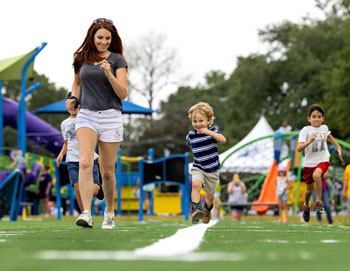
“Splash pads are great playgrounds for intergenerational activity,” continued Spencer. “They can be designed with soft ground sprays in one area that are suitable for the youngest family members, all the way up to big dumping buckets that older kids and young adults like. Providing family gathering areas around the perimeter also offers spaces where family can get together and compare experiences in the space.”
In fact, Spencer found that one of the most interesting trends to emerge from the “COVID period” was how families began to recreate together again. “We all know how the outdoors grew in popularity, but additionally, staying within our family unit is how we felt most safe. This trend has continued to this day. Because of this, designing intentional places where people of all ages can play together is very important. This means a playground is more than a traditional child-focused space, but a space built to encourage intergenerational interaction.”
And as families started to simply get outdoors for walks again, Spencer said that walking paths that provide activities and signage around nature also encourage family interaction. “Be sure to provide seating along the way so older and younger members can rest as they go.”
And she said that when considering traditional playground equipment, don’t forget to add movement. “Older people enjoy swinging, spinning, seesaws and whirls, which don’t involve running and jumping, but ‘playing in place,’ which can be easier on tender joints. Also, spinning and swinging stimulate vestibular sensation, which is excellent for spatial awareness and balance, both of which are important to older people.”
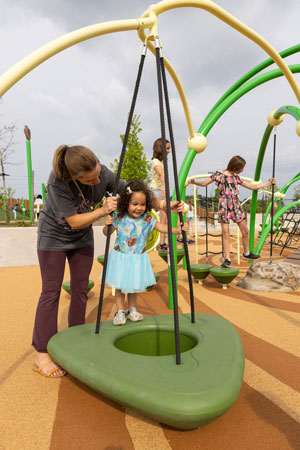
DeMelo said they’re looking at nature exploration areas that have less prefabricated plastic and steel components but more of a natural setting. She also mentioned the Studio Ludo/Kaiser Permanente study, which looked at features that drew people into playgrounds and kept them staying longer, and while seating and amenities like restrooms and changing stations were popular, “trees were really important in people spending longer periods of time at playgrounds and revisiting them more frequently.”
Moore said that the addition of play equipment along walking trails and nature paths is growing more common. “I think people are starting to explore the idea of these playable moments. It’s a great way to encourage people to move through a space and really engage as they go along. I’ve seen this done on and along trails, but also in places like outdoor shopping centers. It’s a really fun way to activate spaces.”
Story trails are another trend that Moore really loves. “Images of stories are placed on panels and families can walk through and read the story as they go. These are such a fun way to explore and add in some movement, while also encouraging reading and learning.”
She added that scavenger hunts are popular, and “musical play is also a really successful multigenerational activity.” Indeed, kids and adults enjoy making music together on bells, drums, marimbas, metallophones and chimes—being creative while spending times outdoors.
There are also companies making interesting interactive playground equipment. One offering is an interactive dance and play arch, where parents and kids can dance and play games in motion—great for getting people up and moving. Another product offers interactive play pillars that feature a number of games with simple rules. These types of interactive offerings can build connections between generations.
Founded more than 25 years ago, KABOOM! has built or improved more than 17,000 play spaces. “Oftentimes the focal point will be the playground itself,” said DeMelo, “but we also do additional enhancements in that entire environment.”
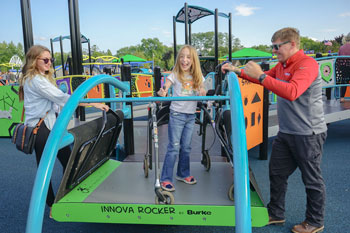
She explained that when working with communities, they have people spanning all ages who contribute to the conversation and overall vision of what the space may entail. “Over the years we’ve learned from others what’s important to them, and it could be something as simple as seating or it can be a bit more creative.”
DeMelo recalled working on a project with a team in San Francisco who had engaged multiple generations in the planning process. “One thing that was important to them was passing on certain cultural dances from one generation to the next, and they used this concept of dancing footsteps that were painted on the ground as another activity outside of the playground that would encourage learning and passing along to different generations this concept of the dance that was important to the community.
“And in some places you might see the importance of games,” she continued, “and it might come from the younger generation or the older generation, where we might create a picnic table that has some games on it so they can engage in a different type of play.”
She said that while they leave a lot of the playground-specific designing to their manufacturing partners, there’s lots of ways to engage the community in the design process in the periphery, but “also we’re engaging the kids and community members and what’s important to them in the play environment itself.”
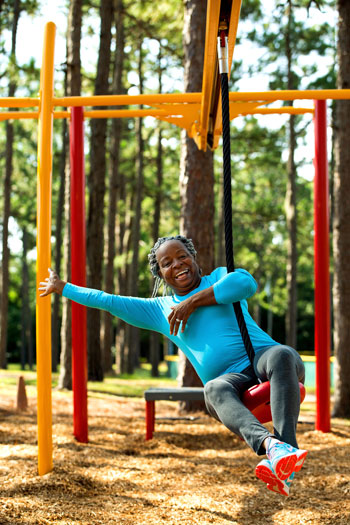
Designing for teens can be a tricky proposition, and DeMelo discussed a recent middle school play space project in Texas. “It was interesting to hear their thoughts and what was important to them. They had these different zones for different types of activities and settings. One of them was physical/active play but another was a social setting; they just wanted a place to hang out with their friends that was pretty, that smelled nice and included flowers, gardens, playful seating and ways to express themselves through a chalkboard and other messaging boards. So once we start to think about the holistic environment communities are describing as their play spaces, it’s not just a destination playground, it’s an environment that people feel joy in.”
Created in 1927, the Maryland-National Capital Park and Planning Commission (M-NCPPC) has endeavored to improve the quality of life for those in Montgomery and Prince George’s Counties, bordering the District of Columbia. One of their program areas involves providing leisure and recreational experiences. Claire Worshtil is capital budget manager with M-NCPPC, and when it comes to play spaces, she said they often incorporate music-making features, splash pads and storefronts or playhouses that are low to the ground and can be accessed by everyone visiting the playground. “There are also a lot of group slide and group swing options that enable people to play together. We know these are a huge hit with kids, but they are requested and enjoyed almost as much by their parents or caretakers!”
Worshtil added that wherever space and budget allow, they like to incorporate fitness equipment next to playgrounds so teens and adults accompanying kids to the playground—but who don’t want to slide or swing—have another option for physical activity. “Overall, parks that have multiple types of amenities are ideal for intergenerational recreation. It’s great to be able to have one child on the soccer field, another playing on the playground, mom or dad getting in a workout on the outdoor fitness equipment and grandma chatting with friends while walking the loop trail. We know the old adage about the family that plays together.”
Worshtil highlighted a few of their projects that promote intergenerational play: a new playground at Chillum Park includes adult fitness equipment next to the playground, which was requested by the community; a recent project where they partnered with KABOOM! features a ninja-warrior-style course in addition to an inclusive playground in a park that also boasts a bike/pedestrian trail and football, soccer and softball fields; they’re constructing a playground with many inclusive elements with a special focus on elements for kids with autism, and constructing another community center playground with inclusive elements and a splash pad. “Each space is designed with the specific needs of its surrounding community in mind, but they’re designed to provide options to those communities as they grow, age and change over time as well.”
In fact, Worshtil said they strive to build inclusive elements into all their playgrounds, and “As an added benefit, these inclusive elements also serve to make our recreational spaces intergenerational.” For example, she mentioned swings that face each other so family members can swing together, that also provide back support for those with low muscle tone. “Creating play spaces on various levels allows residents of different ages and abilities to interact, and there are many new play elements—like merry-go-rounds, rockers and spinners—that are made for varying abilities, ages and body sizes. These inclusive spaces create comfortable play environments for everyone.”
“I’m a big fan of anything that caters to different body types,” said Moore. “Obviously, adults are a bit bigger than children so they’re going to gravitate toward play experiences that they can comfortably engage with.”
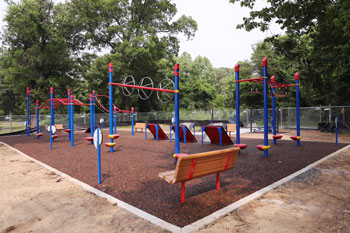
She mentioned multi-user swings as elements offering a comfortable place to sit down and experience a bit of motion, as well an inclusive merry-go-round, glider and seesaw, which all have seats that both kids and adults can effortlessly use. “We tend to see adults engage most with play equipment that’s easy for them to use where they don’t have to bend over or experience undo stress to engage with the piece.”
To appeal to all ages, Moore said the integration of seating, shade and restrooms is critical. “If a parent or caretaker isn’t comfortable or doesn’t have their needs taken care of, then they likely aren’t going to engage with a space for very long and the child doesn’t get to stay and play.”
She said seating should be at different heights to meet the needs of different visitors, and some should be meant to support larger bodies. Shade is critical. And in terms of restrooms, she said they’re seeing a huge push for universal changing tables, to accommodate families with older kids with disabilities. “Things like fencing also help, knowing that a child is contained and not going to make a break for something dangerous.
“In terms of parking, we encourage additional accessible parking spots if the park has the space for it,” Moore continued. “To go a step further, it’d be great to include accessible drop-off areas. Wide curb ramps help provide greater access, including parents with strollers and users with mobility devices. In terms of layout, I work with a designer that always tries to integrate ‘parent pockets’ into park design—spaces where parents can sit that are shady and comfortable, far enough from the playground that they can have their adult time, but close enough in case a child needs them.”
Spencer mentioned a study published by Generations United and the Eisner Foundation titled “I Need You, You Need Me: The Young, The Old and What We Can Achieve Together.” “People who were surveyed admitted living in an age-segregated society. In this study, 53% of American adults say they don’t regularly spend time with individuals much older or younger than they are, outside of their family.”
But on the positive side, Spencer pointed out that people of all ages benefit from the increased physical activity, access to vitamin D, fresh air and reduction of health risk factors associated with outdoor activity.
“For children, play can provide positive impact across all five developmental domains. Being in an outdoor environment helps people relax and can help restore the mind from specific age-related stresses such as school, work, family pressures or loneliness. Green spaces may be particularly beneficial for older adults as they can provide safe opportunities to be active and interact with other people, while stimulating the mind and senses.”
Added DeMelo, “There are a diverse range of ways that people are describing play spaces, and it’s critical to have voices of different generations as we start to think about being responsive to different needs.” RM



